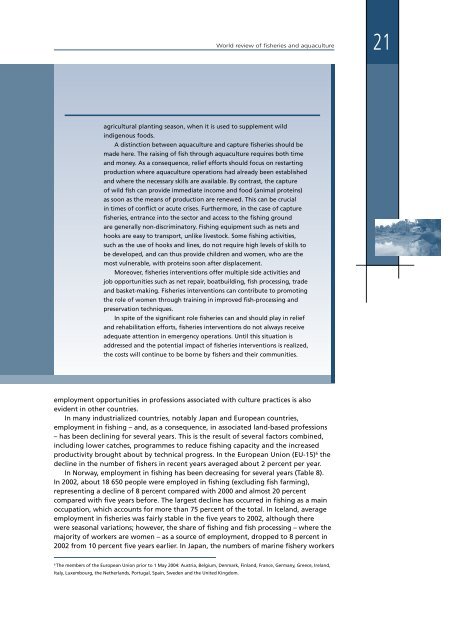State of World Fisheries and Aquaculture 2004 - Library
State of World Fisheries and Aquaculture 2004 - Library
State of World Fisheries and Aquaculture 2004 - Library
You also want an ePaper? Increase the reach of your titles
YUMPU automatically turns print PDFs into web optimized ePapers that Google loves.
<strong>World</strong> review <strong>of</strong> fisheries <strong>and</strong> aquaculture<br />
21<br />
agricultural planting season, when it is used to supplement wild<br />
indigenous foods.<br />
A distinction between aquaculture <strong>and</strong> capture fisheries should be<br />
made here. The raising <strong>of</strong> fish through aquaculture requires both time<br />
<strong>and</strong> money. As a consequence, relief efforts should focus on restarting<br />
production where aquaculture operations had already been established<br />
<strong>and</strong> where the necessary skills are available. By contrast, the capture<br />
<strong>of</strong> wild fish can provide immediate income <strong>and</strong> food (animal proteins)<br />
as soon as the means <strong>of</strong> production are renewed. This can be crucial<br />
in times <strong>of</strong> conflict or acute crises. Furthermore, in the case <strong>of</strong> capture<br />
fisheries, entrance into the sector <strong>and</strong> access to the fishing ground<br />
are generally non-discriminatory. Fishing equipment such as nets <strong>and</strong><br />
hooks are easy to transport, unlike livestock. Some fishing activities,<br />
such as the use <strong>of</strong> hooks <strong>and</strong> lines, do not require high levels <strong>of</strong> skills to<br />
be developed, <strong>and</strong> can thus provide children <strong>and</strong> women, who are the<br />
most vulnerable, with proteins soon after displacement.<br />
Moreover, fisheries interventions <strong>of</strong>fer multiple side activities <strong>and</strong><br />
job opportunities such as net repair, boatbuilding, fish processing, trade<br />
<strong>and</strong> basket-making. <strong>Fisheries</strong> interventions can contribute to promoting<br />
the role <strong>of</strong> women through training in improved fish-processing <strong>and</strong><br />
preservation techniques.<br />
In spite <strong>of</strong> the significant role fisheries can <strong>and</strong> should play in relief<br />
<strong>and</strong> rehabilitation efforts, fisheries interventions do not always receive<br />
adequate attention in emergency operations. Until this situation is<br />
addressed <strong>and</strong> the potential impact <strong>of</strong> fisheries interventions is realized,<br />
the costs will continue to be borne by fishers <strong>and</strong> their communities.<br />
employment opportunities in pr<strong>of</strong>essions associated with culture practices is also<br />
evident in other countries.<br />
In many industrialized countries, notably Japan <strong>and</strong> European countries,<br />
employment in fishing – <strong>and</strong>, as a consequence, in associated l<strong>and</strong>-based pr<strong>of</strong>essions<br />
– has been declining for several years. This is the result <strong>of</strong> several factors combined,<br />
including lower catches, programmes to reduce fishing capacity <strong>and</strong> the increased<br />
productivity brought about by technical progress. In the European Union (EU-15) 6 the<br />
decline in the number <strong>of</strong> fishers in recent years averaged about 2 percent per year.<br />
In Norway, employment in fishing has been decreasing for several years (Table 8).<br />
In 2002, about 18 650 people were employed in fishing (excluding fish farming),<br />
representing a decline <strong>of</strong> 8 percent compared with 2000 <strong>and</strong> almost 20 percent<br />
compared with five years before. The largest decline has occurred in fishing as a main<br />
occupation, which accounts for more than 75 percent <strong>of</strong> the total. In Icel<strong>and</strong>, average<br />
employment in fisheries was fairly stable in the five years to 2002, although there<br />
were seasonal variations; however, the share <strong>of</strong> fishing <strong>and</strong> fish processing – where the<br />
majority <strong>of</strong> workers are women – as a source <strong>of</strong> employment, dropped to 8 percent in<br />
2002 from 10 percent five years earlier. In Japan, the numbers <strong>of</strong> marine fishery workers<br />
6<br />
The members <strong>of</strong> the European Union prior to 1 May <strong>2004</strong>: Austria, Belgium, Denmark, Finl<strong>and</strong>, France, Germany, Greece, Irel<strong>and</strong>,<br />
Italy, Luxembourg, the Netherl<strong>and</strong>s, Portugal, Spain, Sweden <strong>and</strong> the United Kingdom.

















